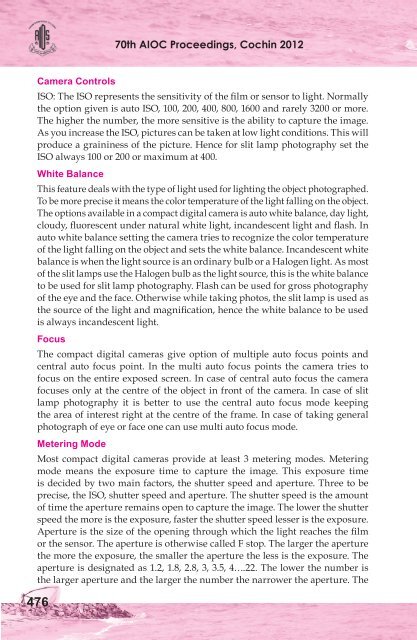Comprehensive Ophthalmology Free Papers - aioseducation
Comprehensive Ophthalmology Free Papers - aioseducation
Comprehensive Ophthalmology Free Papers - aioseducation
You also want an ePaper? Increase the reach of your titles
YUMPU automatically turns print PDFs into web optimized ePapers that Google loves.
70th AIOC Proceedings, Cochin 2012<br />
Camera Controls<br />
ISO: The ISO represents the sensitivity of the film or sensor to light. Normally<br />
the option given is auto ISO, 100, 200, 400, 800, 1600 and rarely 3200 or more.<br />
The higher the number, the more sensitive is the ability to capture the image.<br />
As you increase the ISO, pictures can be taken at low light conditions. This will<br />
produce a graininess of the picture. Hence for slit lamp photography set the<br />
ISO always 100 or 200 or maximum at 400.<br />
White Balance<br />
This feature deals with the type of light used for lighting the object photographed.<br />
To be more precise it means the color temperature of the light falling on the object.<br />
The options available in a compact digital camera is auto white balance, day light,<br />
cloudy, fluorescent under natural white light, incandescent light and flash. In<br />
auto white balance setting the camera tries to recognize the color temperature<br />
of the light falling on the object and sets the white balance. Incandescent white<br />
balance is when the light source is an ordinary bulb or a Halogen light. As most<br />
of the slit lamps use the Halogen bulb as the light source, this is the white balance<br />
to be used for slit lamp photography. Flash can be used for gross photography<br />
of the eye and the face. Otherwise while taking photos, the slit lamp is used as<br />
the source of the light and magnification, hence the white balance to be used<br />
is always incandescent light.<br />
Focus<br />
The compact digital cameras give option of multiple auto focus points and<br />
central auto focus point. In the multi auto focus points the camera tries to<br />
focus on the entire exposed screen. In case of central auto focus the camera<br />
focuses only at the centre of the object in front of the camera. In case of slit<br />
lamp photography it is better to use the central auto focus mode keeping<br />
the area of interest right at the centre of the frame. In case of taking general<br />
photograph of eye or face one can use multi auto focus mode.<br />
Metering Mode<br />
Most compact digital cameras provide at least 3 metering modes. Metering<br />
mode means the exposure time to capture the image. This exposure time<br />
is decided by two main factors, the shutter speed and aperture. Three to be<br />
precise, the ISO, shutter speed and aperture. The shutter speed is the amount<br />
of time the aperture remains open to capture the image. The lower the shutter<br />
speed the more is the exposure, faster the shutter speed lesser is the exposure.<br />
Aperture is the size of the opening through which the light reaches the film<br />
or the sensor. The aperture is otherwise called F stop. The larger the aperture<br />
the more the exposure, the smaller the aperture the less is the exposure. The<br />
aperture is designated as 1.2, 1.8, 2.8, 3, 3.5, 4….22. The lower the number is<br />
the larger aperture and the larger the number the narrower the aperture. The<br />
476

















